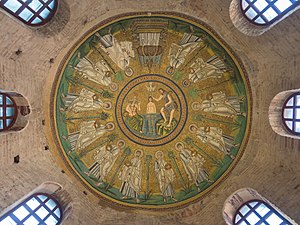Arian Baptistery
The Arian Baptistery ( Baptistery of the Arians ) is an ancient ecclesiastical structure in Ravenna , Italy . It was built towards the end of the 5th century when Theodoric the Great strengthened his rule and Christianity in the Arian or more correctly in the Homoic form became the official court religion. Compared to the cathedral baptistery , it is simpler and in a worse state of preservation.
The baptistery is especially famous, like other Byzantine buildings in Ravenna, because of the ceiling mosaics in its interior. Along with other early church buildings in the city, the Arian Baptistery is a UNESCO World Heritage Site .
In the second half of the 6th century the baptistery was converted by the Roman Catholic Church into the oratory of S. Maria in Cosmedin.
Outdoor area
The octagonal building with four apses is now approx. 2.25 m below it because of the steep rise in the ground level in Ravenna since ancient times.
inner space
Inside, only the dome's mosaic decoration remained . This is very similar to that of the Baptistery of Ravenna's Cathedral , which probably served as a direct model. The central medallion depicts the baptism of Christ in the Jordan . The Savior , completely naked, is baptized by the Holy Spirit in the form of a dove , at the same time John the Baptist pours water on his head; the third figure, holding a green swamp pipe, symbolizes the Jordan River. Since even the genitals of Jesus (unusual in Byzantine art) are recognizable, the representation, according to older literature, is sometimes seen as influenced by Arian Christianity. Whether homeic theology actually had an impact on the iconography of the baptismal scene cannot be proven due to a lack of comparative examples; at least there is no theological foundation for this in homeic Christianity. In fact, on the dome mosaic of the Orthodox baptistery, Ravenna's genitalia can be seen, if not so clearly. Another, probably the more likely, cause of this form of representation is the pagan tradition, which was still noticeable in the late 5th century. In Greek and Roman art, depictions of male nudity, especially in the sacred area, are of course not unusual.
The apostles are represented in full on the dome mosaic, are separated from one another by stylized palm trees , wear white robes and a halo around their heads . A hetoimasia is depicted between St. Peter carrying the heavenly keys and St. Paul holding a scroll : a large cross with a throne that gives Christ the first place.
sightseeing
Until November 2016, the Arian Baptistery was the only World Heritage Site in Ravenna that could be visited without an entrance fee. Since then, an entry fee of € 2 has been charged.
photos
Web links
Coordinates: 44 ° 25 '7.4 " N , 12 ° 12' 8.6" E




